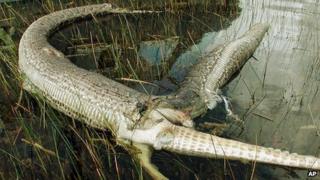
Image caption Pythons occasionally tackle alligators, which can end badly for both animals
Non-native Burmese pythons are the likely cause of a staggering mammal decline in Florida’s Everglades.
In PNAS journal, scientists report that observations of some mammal species have declined by more than 99%.
A team studied road surveys of mammals in the Everglades National Park before and after pythons became common.
The researchers found a strong link between the spread of pythons and drops in recorded sightings of racoons, rabbits, bobcats and other species.
The national park covers the southern 25% of the original Everglades – a region of subtropical wetlands that has been drained over the last century to reclaim it for human use.
The origins of Burmese pythons in south Florida are unknown, but many were imported into the US through the pet trade.
As the pythons have made it from captivity into the wild, the absence of natural predators has allowed populations to balloon. Intermittent sightings were recorded for 20 years before the snakes were recognised as being established across the Everglades in 2000.
The pythons are now found across thousands of sq km in southern Florida. Although there are no accurate figures for how many there are, the numbers removed from the Everglades reached nearly 400 in 2009 and this has been increasing year-on-year (apart from a slight drop in 2010 due to a cold spell).
“Any snake population – you are only seeing a small fraction of the numbers that are actually out there,” said Prof Michael Dorcas, one of the study’s authors, from Davidson College in North Carolina.
He told BBC News: “They are a new top predator in Everglades National Park – one that shouldn’t be there.”
“We have documented pythons eating alligators, we have also documented alligators eating pythons. It depends on who is biggest during the encounter.”
Earlier this month, US Interior Secretary Ken Salazar announced that the US was poised toapprove a ban on importingBurmese pythons. But some observers remarked that the move was about 30 years too late.
Prof Dorcas and his colleagues looked at data on mammals found during roadkill surveys from 1993-1999, and on live and dead mammals encountered during nighttime road surveys from 1996-1997.
They then compared these results with similar data collected between 2003 and 2011, after the pythons were recognised as being established.
They found that observations of raccoons and opossums had dropped by about 99%. There had been a 94.1% fall in observations of white-tailed deer and an 87.5% decrease in sightings of bobcats.
No rabbits or foxes were seen during the more recent survey; rabbits were among the most common mammals in the roadkill survey between 1993 and 1999.
Getting ambushed?
The majority of these species have been documented in the diet of pythons found in the Everglades National Park. Indeed, raccoons and oppossums often forage at the water’s edge, where they are vulnerable to ambush by pythons.
Observations of rodents, coyotes and Florida panthers had increased slightly, but the overall number of sightings remained low.
The researchers also found that the declines in mammals coincided geographically with the spread of Burmese pythons. Mammal species are more common in areas where pythons have only been recently introduced, and are most abundant outside the snakes’ current range.
Prof Dorcas said more research was needed to assess the impact of such large declines. But he added: “It’s not unreasonable to assume that any time we have major declines in mammals like this it’s going to have overall impacts on the ecosystem. Exactly what those are going to be, we don’t know. But it’s possible they could be fairly profound.”
The ban on importing Burmese pythons has come after five years of debate and lobbying in Washington DC. Florida’s Democrat Senator Bill Nelson was among those who campaigned for a ban, unravelling the skin of a 5m-long Everglades python at a 2009 Senate hearing to make his point.
But reptile breeders and collectors had disputed that the tropical snakes posed much risk beyond south Florida and argued that any ban would harm a multi-million dollar industry.
Although the ban will not reverse the situation in southern Florida, where the reptiles are already established, Prof Dorcas said it could help prevent their spread to other suitable habitats in the US, such as southern Louisiana and south Texas.
Pythons linked to Florida Everglades mammal decline have 790 words, post on www.bbc.com at 2012-03-01 15:54:01. This is cached page on WBNews. If you want remove this page, please contact us.
